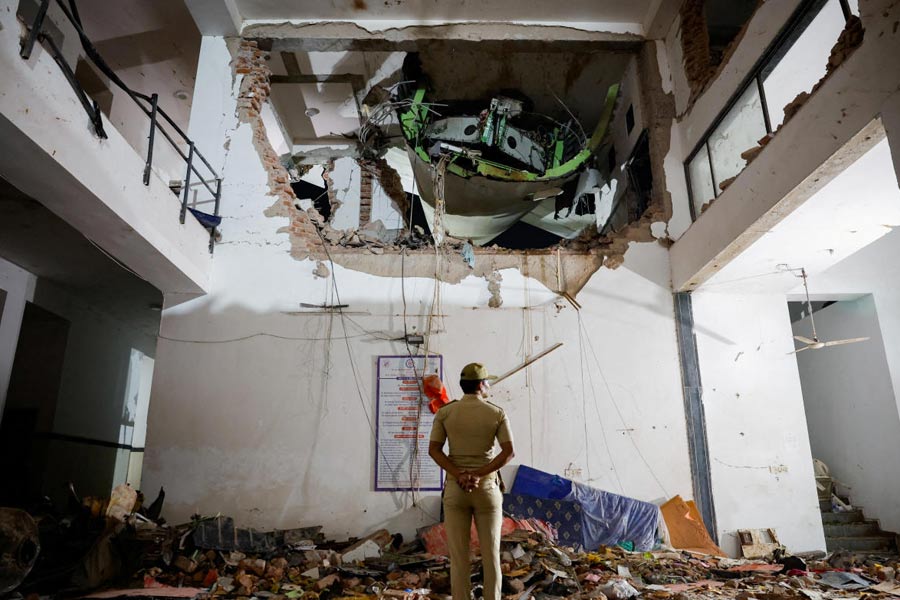 |
| Children sail through a road during flood in Assam |
The annual floods in Assam has seen much deliberation at various levels of governance, but concrete, fruitful steps are elusive
Floods in Assam has become an annual ritual and very year it causes immense loss of life and property. The northeast and southwest monsoon has an immense impact by causing heavy showers in the northeastern region, surrounded by lofty mountain peaks. Water flowing down from the Himalayan foothills in the north and east and from Meghalaya, rushes into the Brahmaputra through various tributaries. To this, rain contributes its share. Water from the tributaries merges with the Brahmaputra, whose ultimate course is the Bay of Bengal. In fact, the Brahmaputra has till now lost its degree of consistency to bear the voluminous water after the earthquake of August 15, 1950, which has raised its base considerably.
Heavy silt deposits hindrance the river?s natural course and flow. Rise in the height of the riverbed causes water from tributaries to spill into the plains, causing floods. The inundation causes enormous loss of life and property. Thousands are left homeless, causing immense suffering.
Previously, flood was limited to certain areas only, but now its causes extensive damage. Most parts of the state, except some high-level and hilly areas, remain submerged. Flood has become a chronic problem, affecting Assam almost four to five times in a year. We all have heard about the river Hwang-Ho as ?China?s Sorrow?. Now, we can also call Brahmaputra and its tributaries ?Assam?s sorrow?.
Guwahati, the nerve centre of business of the Northeast, is also not spared from floods either. Artificial floods are caused by the incessant rains, four to five times every year. The main water outlet of the city is Bharalu, which is not adequately wide and deep. When the bed of the Brahmaputra is high, the sluice gate at the Bharulu-Brahmaputra mouth point also remains closed.
Naturally, water from Bharalu flows into the city and submerges it. Unplanned earth-cutting and filling without proper drainage system, causes waterlogging in different areas. Landslides, on the other hand, is a serious threat to the people living on the hills.
Floods also disrupt communication. People of different areas get marooned. The state government, however, fails to show proper interest in the issue. The Union government also turns a deaf ear to the acute sufferings of the people.
The aid provided can?t compensate the heavy loss and hardly cater to the needs of the flood victims. Prime Minister Manmohan Singh recently paid a three-hour hurricane tour of the state and did an hour?s aerial survey. Congress president Sonia Gandhi also paid a visit and studied the situation. A heavy amount is spent from the state coffers in the name of security and other allied expenses, rather than on giving compensation to the flood victims. In a sense, the aid of Rs 20 lakh offered by her could hardly cover the burden shouldered by the state for the visit.
The Assam government demanded Rs 1,200 crore for relief and rehabilitation activities, but it was provided Rs 181 crore only. A further sanction of Rs 200 crore is reported to have been made. A high-level team visited Assam to assess the loss. Red tape will surely delay the process. The distressed flood victims are helpless and will continue to suffer post-flood ailments. There is no guarantee of fair and equal distribution of both money and material.
Precedence reminds us that such amounts are always mis-used, mis-utilised and mis-appropriated. The recent furore on the floor of the state Assembly on the rice scandal exposes the performance of the state machinery.
Floods in Assam is a national problem. The people of Assam have long been demanding that floods be considered a national problem. During his recent visit to Guwahati, the Union minister for water resources, Priya Ranjan Das Munshi, said Assam floods was a national problem and the issue would be placed before the Union cabinet for discussion, as a prelude to arrive at a final decision in Parliament. The minister?s concern has flown out of the windows now.
The floods in Assam has now become a burning question. A dredger was brought to Assam for clearing the Brahmaputra of silt in the seventies. But it could not be utilised for want of skilled manpower. If an exercise is started for digging the Brahmaputra in a phased manner, then there can be some productive results.
It has, of late, been observed that the stored water of Bhutan, China and Tibet make downward trend due to breach of dams for which the Assam rivers and tributaries immediately swell up. Sabotage is suspected behind the discharge. It is imperative that there should be forceful and meaningful dialogue between India and other countries on such breach of dams or discharge of water so as to avert any unhealthy and unfortunate recurrence.
A river-linking proposal in the inter-state level is now very much in the offing. There cannot be any objection, if surplus water of the Brahmaputra is diverted to Uttar Pradesh, Madhya Pradesh and Rajasthan. But on the other hand, if water is taken disproportionately in the post-monsoon season, the high riverbed of the Brahmaputra may dry up. Agricultural productivity may be reduced as a result of lack of water.
The Assam rivers and tributaries have immense potential for power generation and irrigation projects. A proper development of industry and agriculture can be ensured, if such potential resources are utilised. In such exercise, the chronic power crisis in the state would have been improved as well. This would accelerate the economic growth and open avenues of employment as well.
The Prime Minister gave an indication of creation of a taskforce for the purpose, but many others differ as such an exercise will be time-consuming and waste a lot of money. The Brahmaputra Board can be well revamped instead for undertaking such task with skilled manpower.
The people of Assam are already disturbed and frustrated. It is high time that government took concrete steps to deal with the problem.










